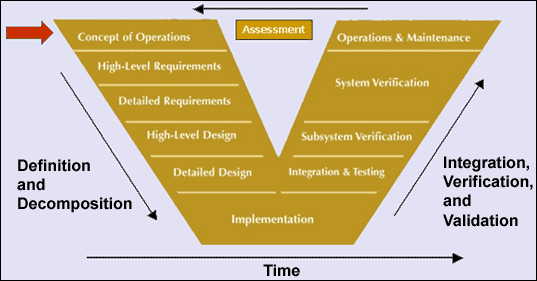About ITS Standards
Systems Engineering
ITS Standards in the Systems Engineering Process
ITS Standards are primarily used in the design stage of the systems engineering process, after a high-level design (project architecture) has been developed. During the detailed design phase, specific messages, data elements, communications profiles, and design options are defined.
Systems Engineering is a process-oriented means of deploying a system that leads to reduced risk, controlled cost and schedule, improved system quality, and a resultant system that meets user needs.
There are multiple ways to represent the systems engineering process. One way, the Systems Engineering "V" Diagram (see figure below), represents the typical life cycle of any system or project. Whether the system being deployed consists of a basic computer-aided dispatch (CAD) system for a transit agency, or a more complex interface between a traffic management center and a public safety agency, all systems will follow some variation of this life cycle.

Stage 1: Concept of Operations - The manner in which the system will be used is defined.
Stage 2: Requirements - High level and detailed requirements define what the system will do.
Stage 3: Design - High-level and detailed specifications define how the system will meet the requirements.
Stage 4: Implementation - The components are built or deployed.
Stage 5: Integration & Testing - As each component of the system is completed, it is integrated into the overall system and tested to ensure that the specifications are satisfied.
Stage 6: System Verification — Also called acceptance testing, this step ensures that the overall system is consistent with the design, and that it meets the requirements.
Stage 7: Operations & Maintenance — This stage represents the ongoing process of using the system in the manner in which it was intended (and validating that it can be used in this way) and maintaining the system.
The systems engineering process is used during the development of ITS standards, as well. All new standards under development, or standards undergoing major revisions, are required to incorporate systems engineering content to help ITS deployers with interpreting and using the standard. For example, the concept of operations developed for an ITS standard may help ITS project designers to conceptualize how messages might be exchanged between systems, such as the order in which control information is sent to a field device and the type of status returned. Additionally, the high-level and detailed requirements developed for an ITS standard might be used to create system functional requirements that could also be used later during system verification.
Learn More…
- Applying Systems Engineering Principles to the Development of Transportation Communication Standards
- CITE Introduction to Systems Engineering - Instructor-led, Web–based ("Blended") Version
- CITE Advanced Systems Engineering for Advanced Transportation Projects web-based course
- ITS T3 (Talking Technology and Transportation) archives. Includes past T3 webinar on subject of Systems Engineering